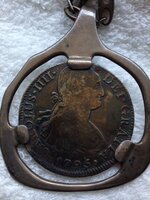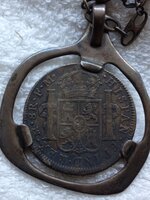G.I.B.
Gold Member
- Feb 23, 2007
- 7,187
- 8,537
- 🏆 Honorable Mentions:
- 1
- Detector(s) used
- CTX 3030 / GTI 2500 / Infinium LS / Tesoro Sand Shark / 1 Garrett Pro-pointer / 1 Carrot / Vibra Probe 580 (out on loan) / Lesche M85 / Mark1 MOD1 EyeBall
- Primary Interest:
- Other
The story:
I'll give as much of the story as I can share-
The coin came from the western caribbean about 25 years ago. The skipper was sailing through an area near shore and stopped for the night. He went snorkeling the next morning to catch a fish in water less than 25' deep.
While hunting he saw this coin, with it's edge sticking sideways up through the sand, and picked up same.
He was unable to continue the hunt and departed the area, years later having the mounting made for his coin.
He was never able to return.
He is now too old to go back and sold his boat several years ago.
He is a good and trusted friend of mine- the story is accurate.
I would like to know about the coin. I'm sure someone here has seen these, and this year, and yes, I'm trying to research the possible wreck this came off of.
So, I'd appreciate any information about this coin that you may have. You should be able to get some pretty good closeups of the coin.
Many thanks.


I'll give as much of the story as I can share-
The coin came from the western caribbean about 25 years ago. The skipper was sailing through an area near shore and stopped for the night. He went snorkeling the next morning to catch a fish in water less than 25' deep.
While hunting he saw this coin, with it's edge sticking sideways up through the sand, and picked up same.
He was unable to continue the hunt and departed the area, years later having the mounting made for his coin.
He was never able to return.
He is now too old to go back and sold his boat several years ago.
He is a good and trusted friend of mine- the story is accurate.
I would like to know about the coin. I'm sure someone here has seen these, and this year, and yes, I'm trying to research the possible wreck this came off of.
So, I'd appreciate any information about this coin that you may have. You should be able to get some pretty good closeups of the coin.
Many thanks.








